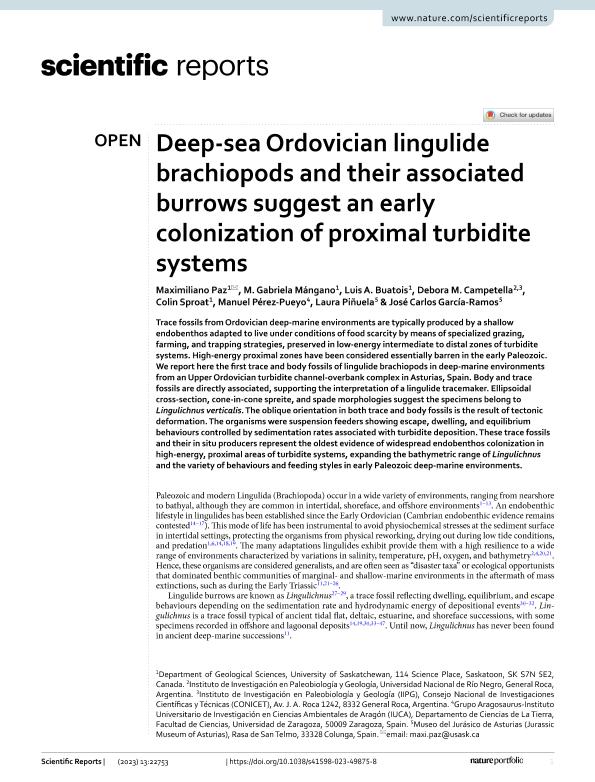Artículo
Deep-sea Ordovician lingulide brachiopods and their associated burrows suggest an early colonization of proximal turbidite systems
Paz, Maximiliano; Mángano, M. Gabriela; Buatois, Luis Alberto ; Campetella, Débora Mical
; Campetella, Débora Mical ; Sproat, Colin; Pérez Pueyo, Manuel; Piñuela, Laura; García Ramos, José Carlos
; Sproat, Colin; Pérez Pueyo, Manuel; Piñuela, Laura; García Ramos, José Carlos
 ; Campetella, Débora Mical
; Campetella, Débora Mical ; Sproat, Colin; Pérez Pueyo, Manuel; Piñuela, Laura; García Ramos, José Carlos
; Sproat, Colin; Pérez Pueyo, Manuel; Piñuela, Laura; García Ramos, José Carlos
Fecha de publicación:
12/2023
Editorial:
Nature
Revista:
Scientific Reports
ISSN:
2045-2322
Idioma:
Inglés
Tipo de recurso:
Artículo publicado
Clasificación temática:
Resumen
Trace fossils from Ordovician deep-marine environments are typically produced by a shallow endobenthos adapted to live under conditions of food scarcity by means of specialized grazing, farming, and trapping strategies, preserved in low-energy intermediate to distal zones of turbidite systems. High-energy proximal zones have been considered essentially barren in the early Paleozoic. We report here the first trace and body fossils of lingulide brachiopods in deep-marine environments from an Upper Ordovician turbidite channel-overbank complex in Asturias, Spain. Body and trace fossils are directly associated, supporting the interpretation of a lingulide tracemaker. Ellipsoidal cross-section, cone-in-cone spreite, and spade morphologies suggest the specimens belong to Lingulichnus verticalis. The oblique orientation in both trace and body fossils is the result of tectonic deformation. The organisms were suspension feeders showing escape, dwelling, and equilibrium behaviours controlled by sedimentation rates associated with turbidite deposition. These trace fossils and their in situ producers represent the oldest evidence of widespread endobenthos colonization in high-energy, proximal areas of turbidite systems, expanding the bathymetric range of Lingulichnus and the variety of behaviours and feeding styles in early Paleozoic deep-marine environments.
Palabras clave:
Lingulichnus
,
Agüeira Formation
,
West Asturian-Leonese Zone
,
Ichonology
Archivos asociados
Licencia
Identificadores
Colecciones
Articulos(IIPG)
Articulos de INSTITUTO DE INVESTIGACION EN PALEOBIOLOGIA Y GEOLOGIA
Articulos de INSTITUTO DE INVESTIGACION EN PALEOBIOLOGIA Y GEOLOGIA
Citación
Paz, Maximiliano; Mángano, M. Gabriela; Buatois, Luis Alberto; Campetella, Débora Mical; Sproat, Colin; et al.; Deep-sea Ordovician lingulide brachiopods and their associated burrows suggest an early colonization of proximal turbidite systems; Nature; Scientific Reports; 13; 1; 12-2023; 1-15
Compartir
Altmétricas



